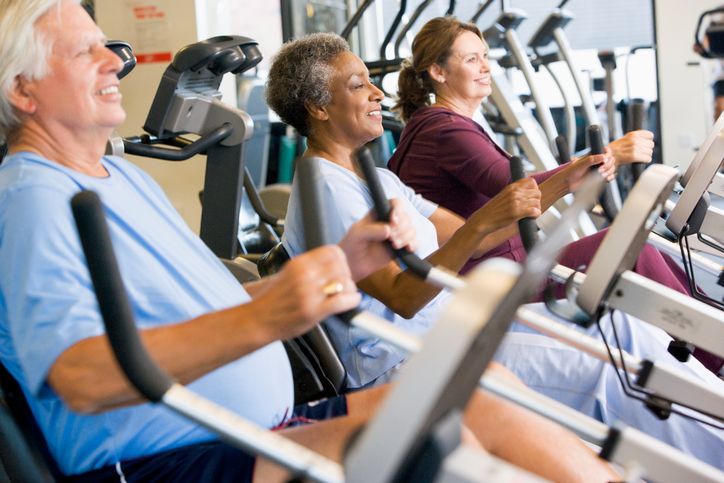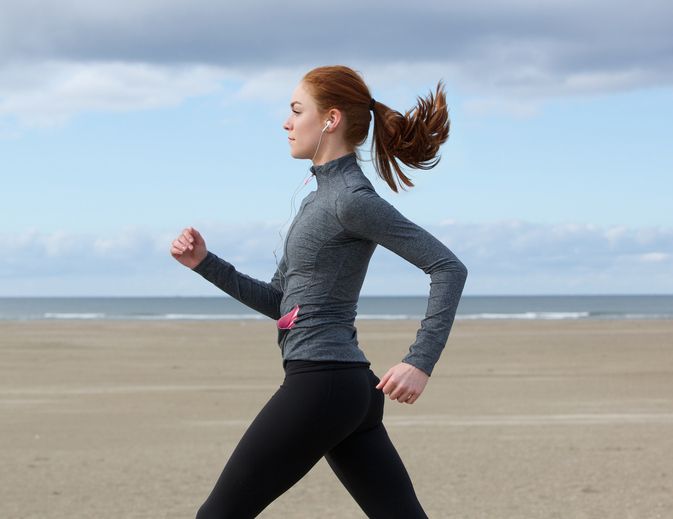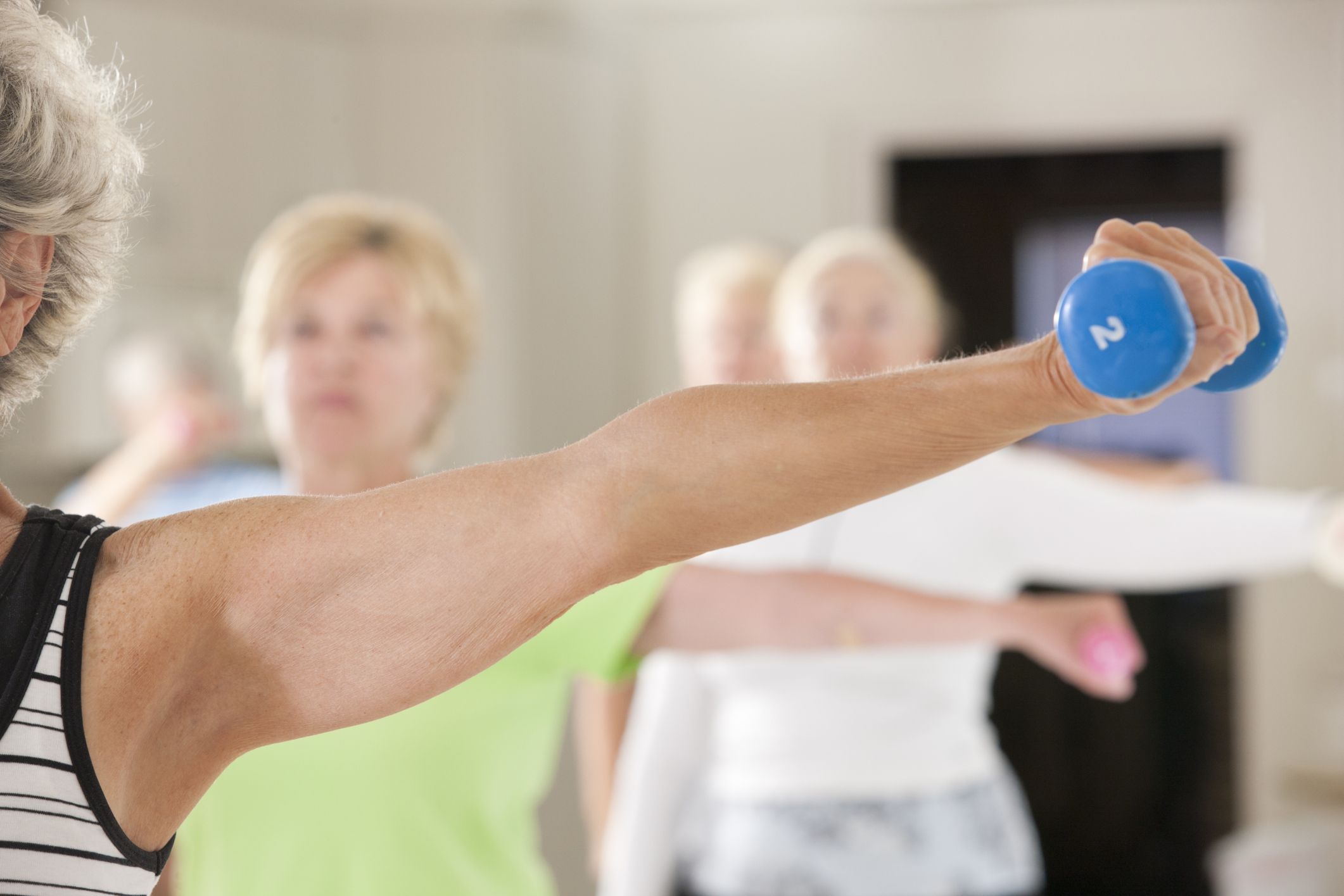Staying Healthy
Exercise and Bone Health
Most people are familiar with many of the benefits of exercise, such as improving muscle strength and endurance, reducing the risk of heart disease and stroke, and preventing obesity. Perhaps not as well understood is the importance of regular physical activity in building and maintaining healthy bones. Inactivity causes loss of bone!
Aging, along with certain diseases and medications, can cause bones to become very weak and fragile over time — a condition called osteoporosis. It often occurs in women after menopause, and in men in older age. This bone-thinning disease raises a person's risk of broken bones, which can seriously limit mobility and independence.
We also tend to lose muscle as we age — a condition called sarcopenia. People who develop osteoporosis or sarcopenia are considered frail: more likely to fall and more likely to break a bone.
Exercise works on bones much like it works on muscles — it makes them stronger. Exercise is important for building strong bones when we are younger, and it is essential for maintaining bone strength when we are older. Because bone is living tissue, it changes over time in response to the forces placed upon it. When you exercise regularly, your bone adapts by building more bone and becoming denser. This improvement in bone requires good nutrition, including adequate calcium and Vitamin D.
Another benefit of exercise is that it improves balance and coordination. This becomes especially important as we get older because it helps to prevent falls and the broken bones that may result.
Exercises for Strong Bones
There are many different types of exercise, including:
- Weightbearing exercises
- Impact exercises
- Strength-training exercises
All of these types of exercise offer health benefits. Exercises to improve bone strength are site-specific. For example, walking and jumping can improve bone strength in the legs and hips but not in the wrist. Strength training that involves lifting and carrying weight can strengthen the hips, spine, and in some cases, the upper extremity (arm) bones.
It is also important to try to have good spine posture with all of your activities. Stretching and strengthening can help prevent or decrease upper spine slumping (kyphosis), which is seen in many older people, and improve posture.
Weightbearing Exercise
Weightbearing describes any activity you do on your feet that works your bones and muscles against gravity. When your feet and legs carry your body weight, more stress is placed on your bones, making your bones work harder. Weightbearing exercise after young adulthood can help prevent further bone loss and strengthen bone.
Examples of weightbearing exercise include:
- Brisk walking and hiking
- Jogging/running
- Dancing
- Jumping rope
- Hopscotch
- Tennis, badminton, ping pong, and pickleball
- Team sports, such as basketball, soccer, and volleyball
- Stair climbing
Impact Exercises
Higher-impact activities, such as jumping off of an 8-inch step or doing a squat jump with a rebound, increase the weight on bones and provide more bone-strengthening benefits. The impact sends a signal to bone cells to build more bone. Even 20 to 30 jumps per day can have a positive effect on bone density, epecially in the hip area.
However, people who are frail or who have already been diagnosed with thinning bone should talk to their doctors about the types of physical activity that would be best for them.
- In cases of severe osteoporosis, jumping may not be advised.
- Jumping can also be painful for people with severe knee pain or arthritis or limited for people with pelvic floor prolapse.
- Many joint replacement surgeons allow some jumping exercises, but depending on your individual history and type of surgery you had, your surgeon may recommend limiting jumping after joint replacement.
Heel drops are an easy alternative to jumping exercises that can be appropriate for many people who can't jump.
Strength-Training Exercise
During strength-training activities, resistance is added to movement to make muscles work harder and, over time, become stronger. Although resistance exercises focus on increasing muscle mass, they also put stress on bones and have bone-building capacity.
Common types of strength training include weight machines, free weights, and exercises (such as push-ups) that use your own body weight. Elastic bands can also be used to add resistance to exercises.
Exercises that require you to carry weight can positively impact the hips and spine.- Common examples are squats, deadlifting, and farmer’s carry. Heavier lifting at lower repetitions can increase bone density more than lighter lifting at higher repetition, but all forms of strength training can benefit bone density.
A general guideline for strength training is to exercise each major muscle group at least twice a week. Be sure to rest for a full day between strength-training sessions.
Other Forms of Exercise
Non-impact exercises, such as yoga and tai chi, are not as effective at strengthening bone, but provide significant flexibility and balance training benefits.
Non-weightbearing exercises, such as swimming, cycling, and chair exercises, do not increase bone density but are excellent choices to strengthen muscles as well as the heart and lungs. If you have a musculoskeletal health condition, such as arthritis, that prevents you from doing weightbearing activities, these are good alternatives.
Starting a Program for Bone Health Fitness
An effective exercise program for bone health includes 30 minutes of weightbearing activity daily. To help you stay motivated, choose an activity that you enjoy. There are many activities that will get you on your feet and moving.
Your 30 minutes of exercise can be done all at once or broken up into shorter intervals. A 10-minute brisk walk three times a day is a great way to get started.
If it is not safe to walk outside, walking throughout your house, climbing stairs indoors and even walking in place are all great weightbearing exercises.
To really reap the benefits of exercise, you need to add flexibility and balance training to the mix. All exercise sessions should end with stretching. Increasing your flexibility improves your ability to move easily, can reduce your risk of injury, and provides mental relaxation benefits.
Before choosing an activity, it is important to consider your risk of falling. Your doctor and a physical therapist can help you plan your exercise program.
People with severe osteoporosis should be careful weightlifting with their arms while standing upright to avoid excessive spine compression (10 to 20 pounds may be safe). They should also avoid exercises that bend or twist the spine.
Using a rowing machine can increase lumbar spine bone density, but it requires good form and may not be a good option for people with severe osteoporosis because of the stress it puts on the spine. People with severe osteoporosis should also avoid contact sports. Floor-based core exercises, like dead bug or reverse crunches, and chair and corner wall exercises can be a safer alternative.
Age and Bone Health Fitness
Adolescents and Young Adults
Building strong bones begins in childhood. The best time to build bone density is during years of rapid growth. We essentially develop the skeleton that must last our lifetime when we are between the ages of 10 and 18 years old. We achieve our peak bone mass in maximum strength and density by age 30.
Weightbearing exercise during the teen years is essential to reach maximum bone strength. A teen's physical activity should include 20 to 30 minutes of weightbearing exercise at least 3 to 4 days each week.
Adults
Once we reach the age of about 25, physical activity alone can no longer increase overall bone mass dramatically, and starting at around age 30, there is a gradual decline.
However, exercise can prevent or slow bone loss, maintain muscle mass to preserve and strengthen surrounding bone, and decrease the risk of falling. Both men and women also need good nutrition, including adequate calcium, Vitamin D, magnesium, and Vitamin K, to preserve their bone mass.
Women and some men in middle age may require hormonal supplementation (estrogens or androgens) to improve or maintain bone mass as they age. Women have accelerated bone loss at a rate of about 2% per year in perimenopause and at menopause, with the greatest rates of bone loss seen a couple of years before and after menopause.
- Menopausal hormone therapy reduces risk of hip fractures by 30% and spine fractures by 40% and can prevent osteoporosis, especially when combined with proper diet and exercise.
- Patients with osteoporosis generally need treatment beyond hormone therapy and are often prescribed other bone-preserving or bone-building medications.
In elderly adults, falls often result in fractures, with long-term consequences that may include:
- Permanent disability
- In the case of hip fractures, death in 15 to 30% of people within 1 to 2 years of the injury
The most common breaks in older people occur in the wrist, spine, and hip.
You can improve balance and mobility with simple balance exercises like brushing your teeth while standing on one leg, or by doing yoga or tai chi. Dancing can also improve balance and mobility. In addition, men and women who participate in regular physical exercise tend to have a lower risk of hip fractures.
Body Weight and Bone Health
When people lose weight, they can also lose bone. Low body weight at any age is associated with a greater risk of bone problems and fractures, but very low body weight has increased consequences for women.
When a person does not consume enough energy (calories) to meet the demands of their athletic training, exercises too much, or a combination of both, it leads to low energy availability. This can result in a condition known as REDs (relative energy deficiency in sport).
Chronic energy deficiency combined with low body weight can cause hormonal changes that stop menstrual periods (amenorrhea). This loss of estrogen — the hormone that is necessary for maintaining bone mass — can cause bone loss at a time when young women should be adding to their peak bone mass.
A woman who misses several menstrual periods, sustains a stress fracture in sports, or has disordered eating should be evaluated for REDs, as this condition can contribute to long-term decreases in bone density. Men can also have REDs and experience bone stress injuries, but the condition is more common in female athletes.
Conclusion
Although exercise has been shown to have clear bone-building effects in children and adolescents and bone-preserving effects in adults, it is just one element of a total program to prevent bone loss and reduce fracture risk.
Understanding your individual risk for osteoporosis, such as genetic factors and family history, is essential. A balanced, calcium-rich diet, adequate Vitamin D, and a healthy lifestyle (avoiding excessive alcohol and nicotine) are also key ingredients for lifelong bone health.
Contributed and/or Updated by
Peer-Reviewed by
AAOS does not endorse any treatments, procedures, products, or physicians referenced herein. This information is provided as an educational service and is not intended to serve as medical advice. Anyone seeking specific orthopaedic advice or assistance should consult his or her orthopaedic surgeon, or locate one in your area through the AAOS Find an Orthopaedist program on this website.









